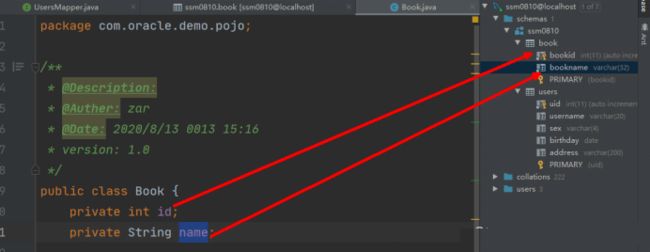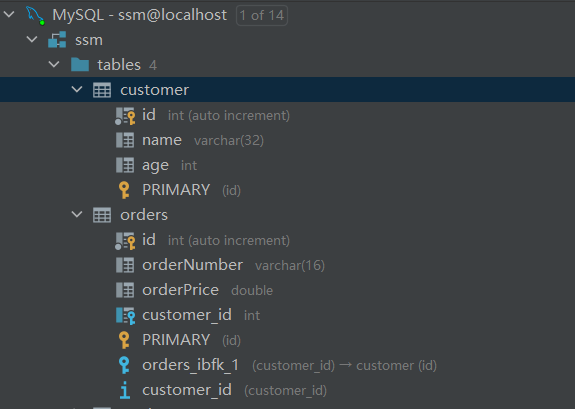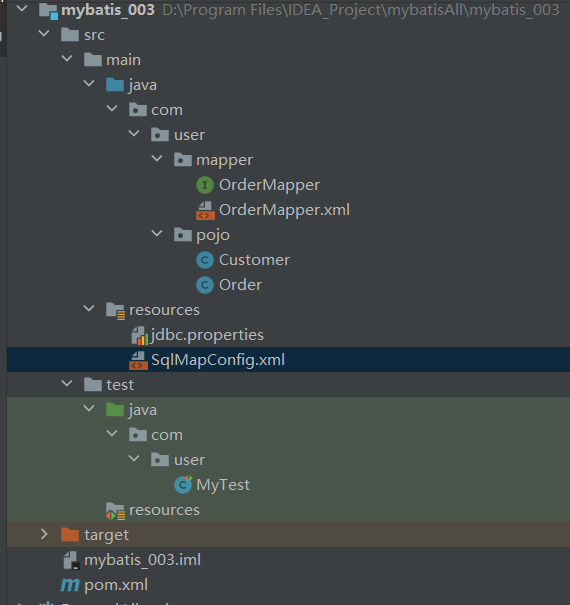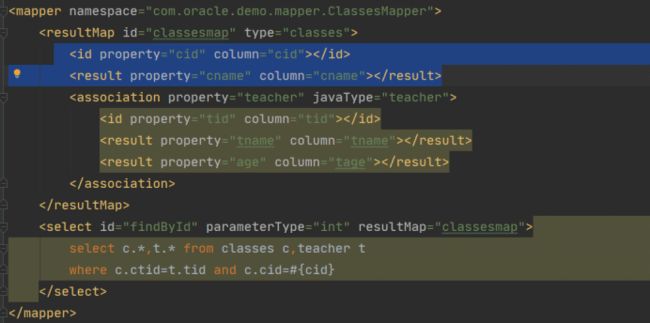导语
关于<resultMap>标签映射,<association>&<collection>的使用
什么时候用<resultMap>标签映射
- 1.当我们查询结果的返回值是由对象封装的且对象中封装了另一个对象时,用标签映射: 具体细节见:Mybatis表的关联查询
- 2.当我们的实体类名与数据库列名不一致时,可以使用标签映射:
什么时候用&
- 当我们的实体类中存有另一个实体类对象时,用
- 一对一、多对一的关联关系一般用
- 当我们的实体类中存有List或map集合是,用
- 一对多的关联关系一般用
- 无论是什么关联关系,如果某方持有另一方的集合,则使用
- 具体细节见:Mybatis表的关联查询
无论是什么关联关系,如果某方持有另一方的集合,则使用标签完成映射,如果某方持有另一方的对象,则使用标签完成映射。
Mybatis表的关联查询
一对多查询
根据顾客ID查询顾客信息(一),同时将顾客名下所有订单查出(多)。
实现思路:
创建顾客类,存储顾客信息:注意我们在顾客类中用List集合封装了顾客名下的订单信息。
package com.user.pojo;
import java.util.List;
public class Customer {
//customer表中的三个列
private Integer id;
private String name;
private Integer age;
//该客户名下所有订单集合
private List orderList;
@Override
public String toString() {
return "Customer{" +
"id=" + id +
", name='" + name + '\'' +
", age=" + age +
", orderList=" + orderList +
'}';
}
public Integer getId() {
return id;
}
public void setId(Integer id) {
this.id = id;
}
public String getName() {
return name;
}
public void setName(String name) {
this.name = name;
}
public Integer getAge() {
return age;
}
public void setAge(Integer age) {
this.age = age;
}
public List getOrderList() {
return orderList;
}
public void setOrderList(List orderList) {
this.orderList = orderList;
}
public Customer(Integer id, String name, Integer age, List orderList) {
this.id = id;
this.name = name;
this.age = age;
this.orderList = orderList;
}
public Customer() {
}
}
创建订单类,存储订单信息:
package com.user.pojo;
public class Order {
private Integer id;
private String orderNumber;
private Double orderPrice;
@Override
public String toString() {
return "Order{" +
"id=" + id +
", orderNumber='" + orderNumber + '\'' +
", orderPrice=" + orderPrice +
'}';
}
public Integer getId() {
return id;
}
public void setId(Integer id) {
this.id = id;
}
public String getOrderNumber() {
return orderNumber;
}
public void setOrderNumber(String orderNumber) {
this.orderNumber = orderNumber;
}
public Double getOrderPrice() {
return orderPrice;
}
public void setOrderPrice(Double orderPrice) {
this.orderPrice = orderPrice;
}
public Order(Integer id, String orderNumber, Double orderPrice) {
this.id = id;
this.orderNumber = orderNumber;
this.orderPrice = orderPrice;
}
public Order() {
}
}
动态代理接口:
package com.user.mapper;
import com.user.pojo.Customer;
public interface CustomerMapper {
//根据客户id查询客户所有信息并同时查询该客户名下的所有订单
Customer getById(Integer id);
}
Mapper.xml文件:
因为我们的查询结果包括该顾客信息和顾客所有的订单信息,所以我们的返回值需要自定义一个map集合来存储。我们这里使用 customermap,并将该集合作为我们的返回值类型。
测试程序:
import java.io.InputStream;
import java.util.List;
public class MyTest {
SqlSession sqlSession;
CustomerMapper customerMapper;
@Before
public void openSqlSession() throws IOException {
InputStream in = Resources.getResourceAsStream("SqlMapConfig.xml");
SqlSessionFactory factory = new SqlSessionFactoryBuilder().build(in);
sqlSession = factory.openSession();
customerMapper = sqlSession.getMapper(CustomerMapper.class);
}
@After
public void closeSqlSession(){
sqlSession.close();
}
@Test
public void testGetCustomerById(){
Customer customer = customerMapper.getById(1);
System.out.println(customer);
}
}
其余基础配置文件SqlMapConfig.xml:
多对一查询
根据订单ID查询订单信息及该订单所属的顾客的信息。
实现思路:
创建订单类,存储订单信息:注意我们在订单类中封装了该订单下的顾客的信息。
package com.user.pojo;
public class Order {
//订单信息
private Integer id;
private String orderNumber;
private Double orderPrice;
private Integer customer_id;
//订单所属的客户
private Customer customer;
@Override
public String toString() {
return "Order{" +
"id=" + id +
", orderNumber='" + orderNumber + '\'' +
", orderPrice=" + orderPrice +
", customer_id=" + customer_id +
", customer=" + customer +
'}';
}
public Integer getId() {
return id;
}
public void setId(Integer id) {
this.id = id;
}
public String getOrderNumber() {
return orderNumber;
}
public void setOrderNumber(String orderNumber) {
this.orderNumber = orderNumber;
}
public Double getOrderPrice() {
return orderPrice;
}
public void setOrderPrice(Double orderPrice) {
this.orderPrice = orderPrice;
}
public Integer getCustomer_id() {
return customer_id;
}
public void setCustomer_id(Integer customer_id) {
this.customer_id = customer_id;
}
public Customer getCustomer() {
return customer;
}
public void setCustomer(Customer customer) {
this.customer = customer;
}
public Order(Integer id, String orderNumber, Double orderPrice, Integer customer_id, Customer customer) {
this.id = id;
this.orderNumber = orderNumber;
this.orderPrice = orderPrice;
this.customer_id = customer_id;
this.customer = customer;
}
public Order() {
}
}
创建顾客类,存储顾客信息:
package com.user.pojo;
import java.util.List;
public class Customer {
//顾客信息
private Integer id;
private String name;
private Integer age;
@Override
public String toString() {
return "Customer{" +
"id=" + id +
", name='" + name + '\'' +
", age=" + age +
'}';
}
public Integer getId() {
return id;
}
public void setId(Integer id) {
this.id = id;
}
public String getName() {
return name;
}
public void setName(String name) {
this.name = name;
}
public Integer getAge() {
return age;
}
public void setAge(Integer age) {
this.age = age;
}
public Customer(Integer id, String name, Integer age) {
this.id = id;
this.name = name;
this.age = age;
}
public Customer() {
}
}
动态代理接口:
package com.user.mapper;
import com.user.pojo.Customer;
import com.user.pojo.Order;
public interface OrderMapper {
//根据主键查订单并同时查询该订单的客户信息
Order getById(Integer id);
}
Mapper.xml文件:
因为我们的查询结果包括该订单信息和订单所属顾客的信息,所以我们的返回值需要自定义一个map集合来存储。我们这里使用 customermap,并将该集合作为我们的返回值类型。
测试类:
package com.user;
import com.user.mapper.OrderMapper;
import com.user.pojo.Order;
import org.apache.ibatis.io.Resources;
import org.apache.ibatis.session.SqlSession;
import org.apache.ibatis.session.SqlSessionFactory;
import org.apache.ibatis.session.SqlSessionFactoryBuilder;
import org.junit.After;
import org.junit.Before;
import org.junit.Test;
import java.io.IOException;
import java.io.InputStream;
public class MyTest {
SqlSession sqlSession;
OrderMapper orderMapper;
@Before
public void openSqlSession() throws IOException {
InputStream in = Resources.getResourceAsStream("SqlMapConfig.xml");
SqlSessionFactory factory = new SqlSessionFactoryBuilder().build(in);
sqlSession = factory.openSession();
orderMapper = sqlSession.getMapper(OrderMapper.class);
}
@After
public void closeSqlSession(){
sqlSession.close();
}
@Test
public void testGetOrderById(){
Order order = orderMapper.getById(11);
System.out.println(order);
}
}
其余基础配置文件:
一对一查询
同多对一。
实体类:
动态代理接口:
mapper.xml文件:
多对多查询
多对多关联中,需要通过中间表化解关联关系。中间表描述两张主键表的关联。
到此这篇关于Mybatis表的关联查询详情的文章就介绍到这了,更多相关Mybatis关联查询内容请搜索脚本之家以前的文章或继续浏览下面的相关文章希望大家以后多多支持脚本之家!








